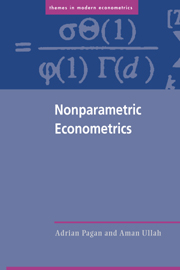Book contents
- Frontmatter
- Contents
- Preface
- 1 Introduction
- 2 Methods of Density Estimation
- 3 Conditional Moment Estimation
- 4 Nonparametric Estimation of Derivatives
- 5 Semiparametric Estimation of Single-Equation Models
- 6 Semiparametric and Nonparametric Estimation of Simultaneous Equation Models
- 7 Semiparametric Estimation of Discrete Choice Models
- 8 Semiparametric Estimation of Selectivity Models
- 9 Semiparametric Estimation of Censored Regression Models
- 10 Retrospect and Prospect
- A Statistical Methods
- References
- Index
5 - Semiparametric Estimation of Single-Equation Models
Published online by Cambridge University Press: 03 December 2009
- Frontmatter
- Contents
- Preface
- 1 Introduction
- 2 Methods of Density Estimation
- 3 Conditional Moment Estimation
- 4 Nonparametric Estimation of Derivatives
- 5 Semiparametric Estimation of Single-Equation Models
- 6 Semiparametric and Nonparametric Estimation of Simultaneous Equation Models
- 7 Semiparametric Estimation of Discrete Choice Models
- 8 Semiparametric Estimation of Selectivity Models
- 9 Semiparametric Estimation of Censored Regression Models
- 10 Retrospect and Prospect
- A Statistical Methods
- References
- Index
Summary
Introduction
Chapters 3 and 4 have been concerned with the estimation of the conditional moments of Y given that X equals some value x and the derivatives of this measure. We have referred to the techniques for doing this as nonparametric, even though it was either necessary to prescribe “parameters” such as the window width for kernel estimators or the number of approximating terms for series estimators. Our use of the term “nonparametric” in that context was prompted by the fact that the “parameters” mentioned did not have any economic meaning. This chapter looks at a different scenario, distinguished by the feature that the models considered contain parameters with some economic meaning and which are the fundamental concern of an investigator, but which also have other aspects that may be difficult to describe convincingly in a parametric fashion. We will refer to these as the class of semiparametric (SP) models, and we will explore a number of members of this class in the following sections. An alternative description would have been seminonparametric (SNP), depending upon where one wishes to place the emphasis, and both terms have appeared in the literature.
Section 5.2 explores the situation when the relationship governing yi can be written as a linear function of some variables x1i and a nonlinear function of other variables x2i, where the nonlinearity is unknown and it is the coefficients of x1i that are of primary interest. By adapting the estimators of Chapter 3, Robinson (1988a) has shown that it is possible to construct an estimator of the parameters of the linear part that exhibits √n consistency.
- Type
- Chapter
- Information
- Nonparametric Econometrics , pp. 196 - 253Publisher: Cambridge University PressPrint publication year: 1999

